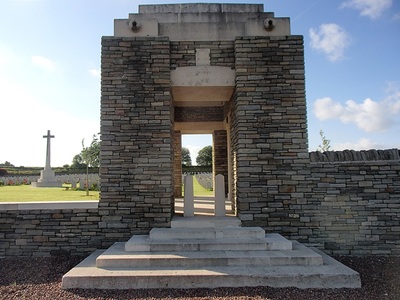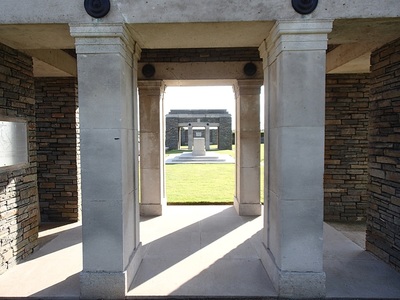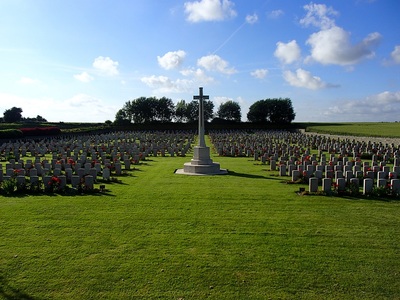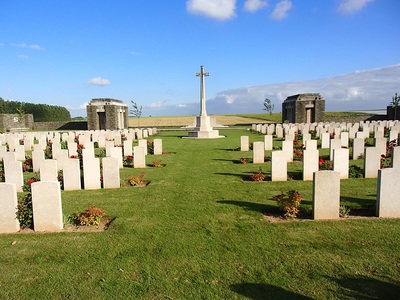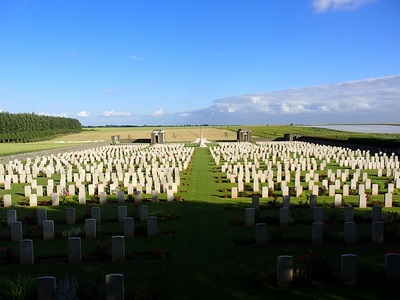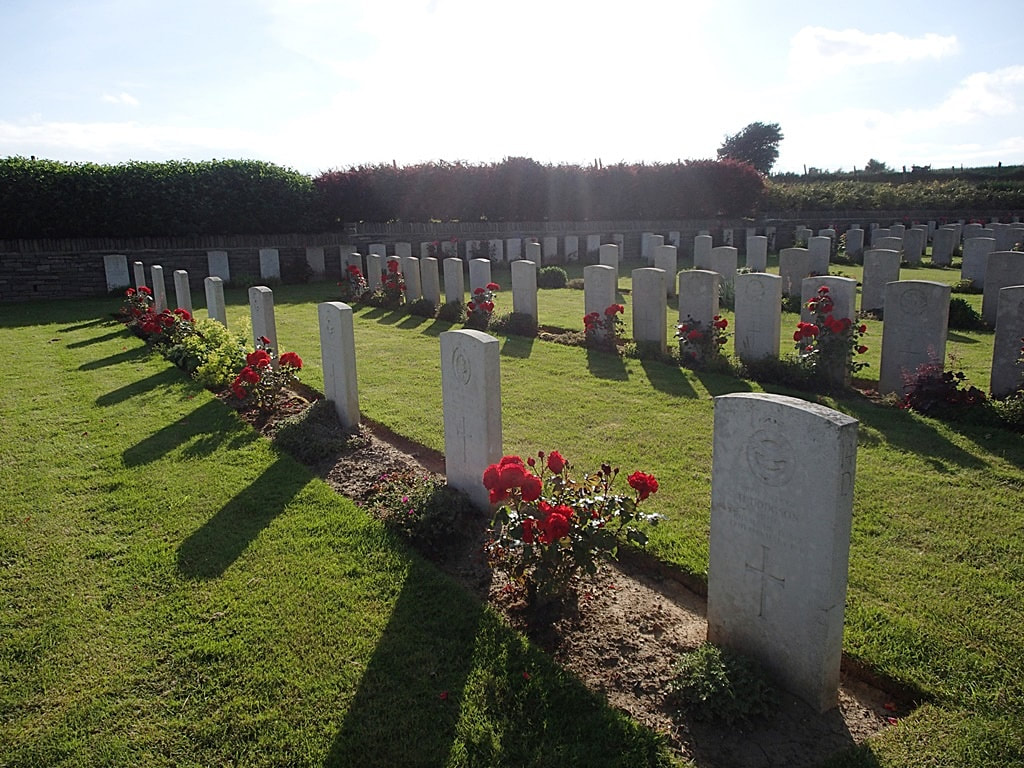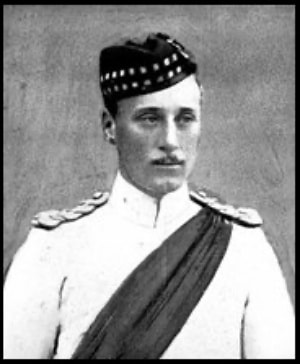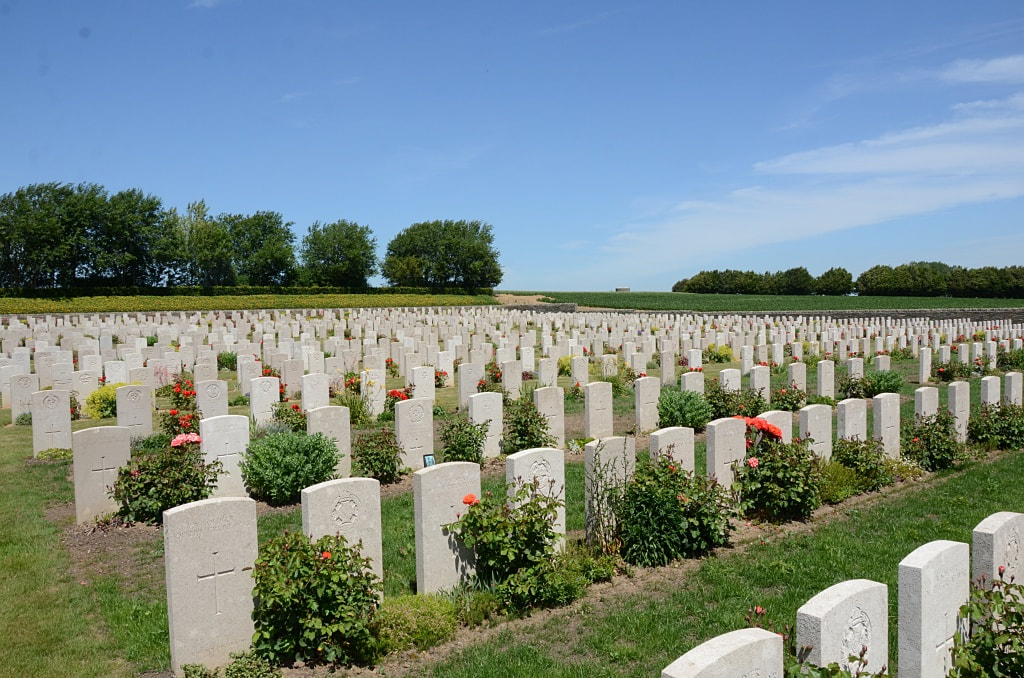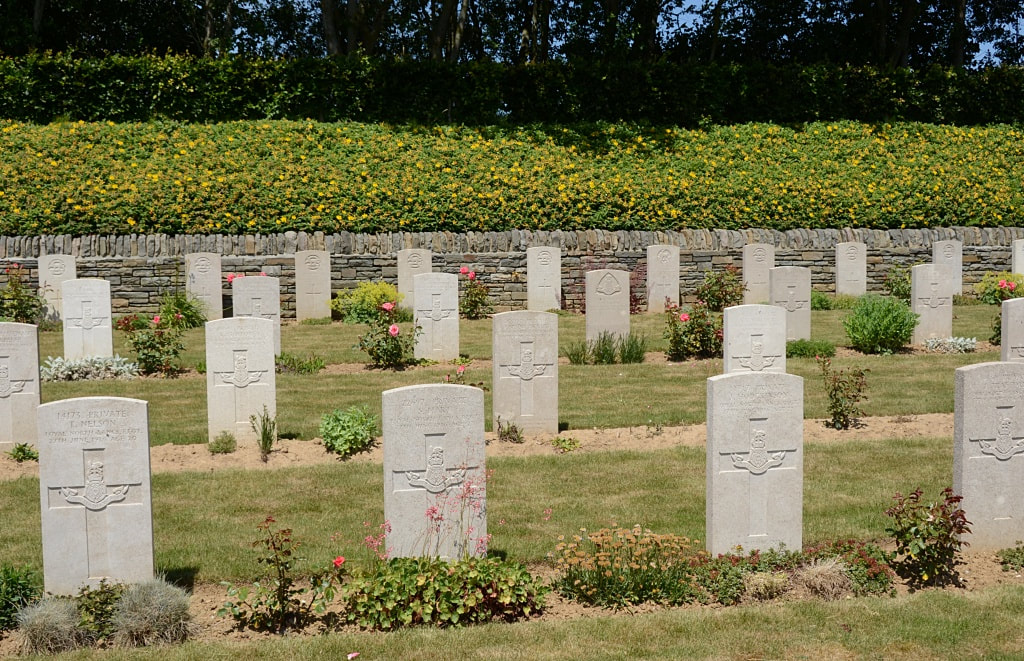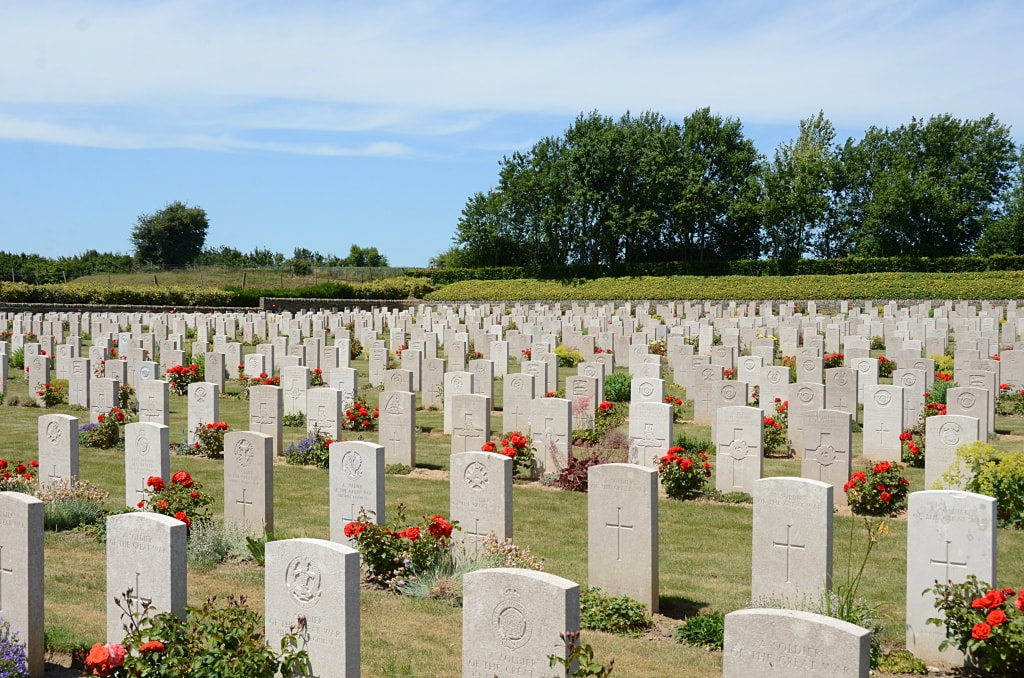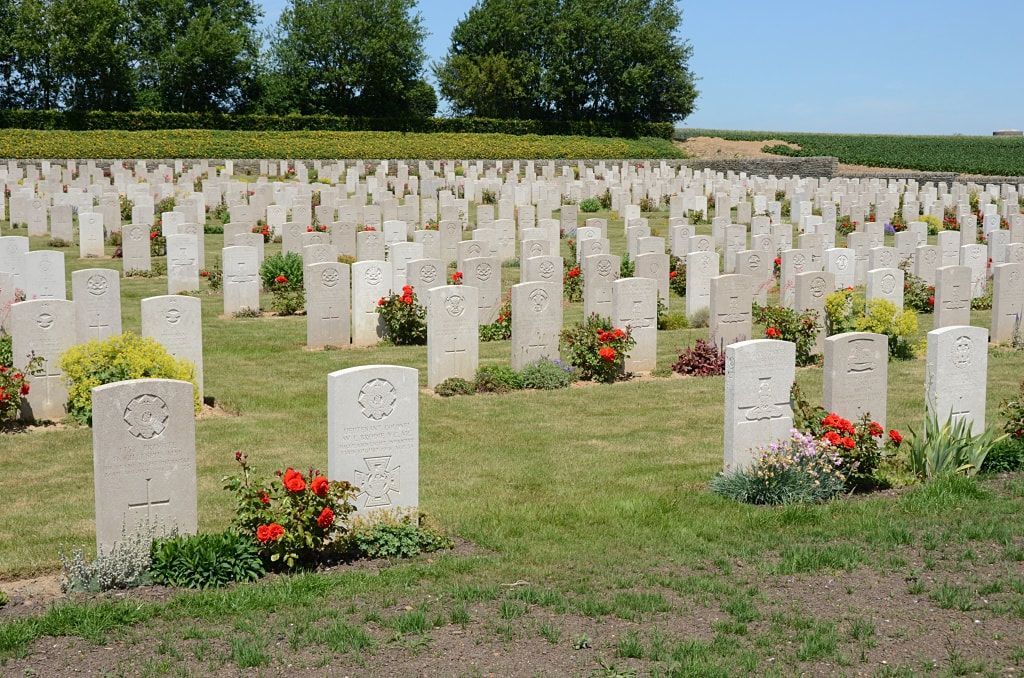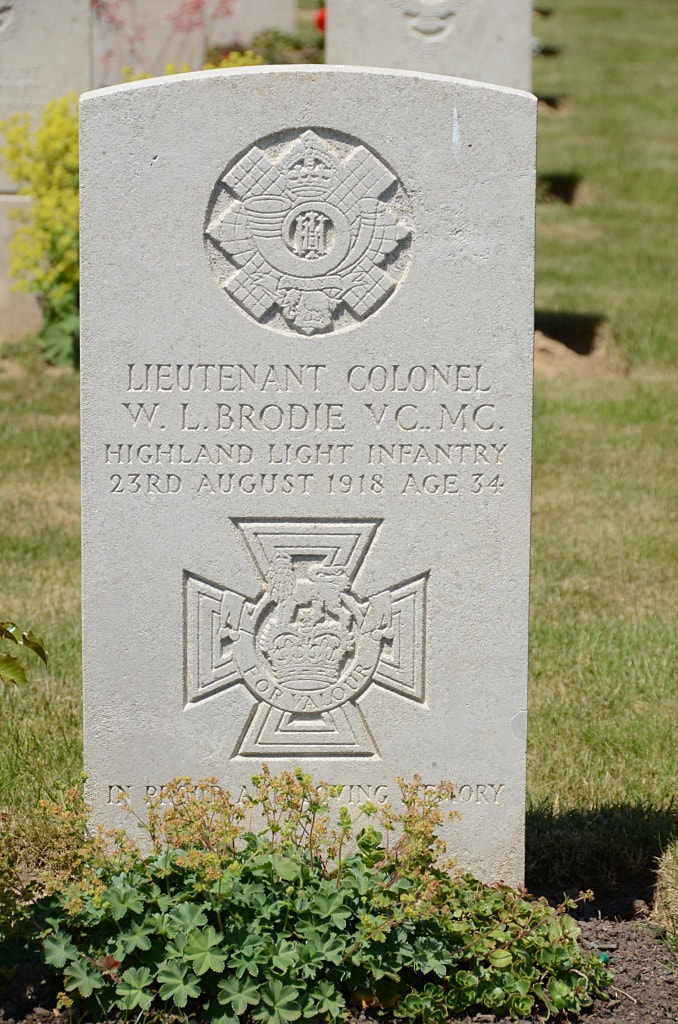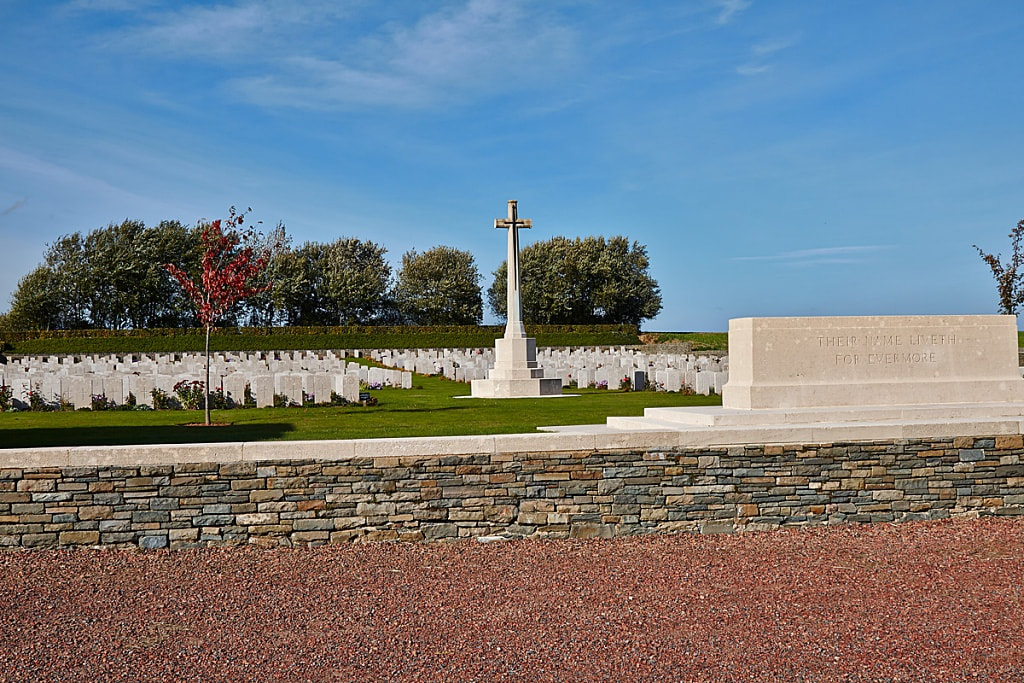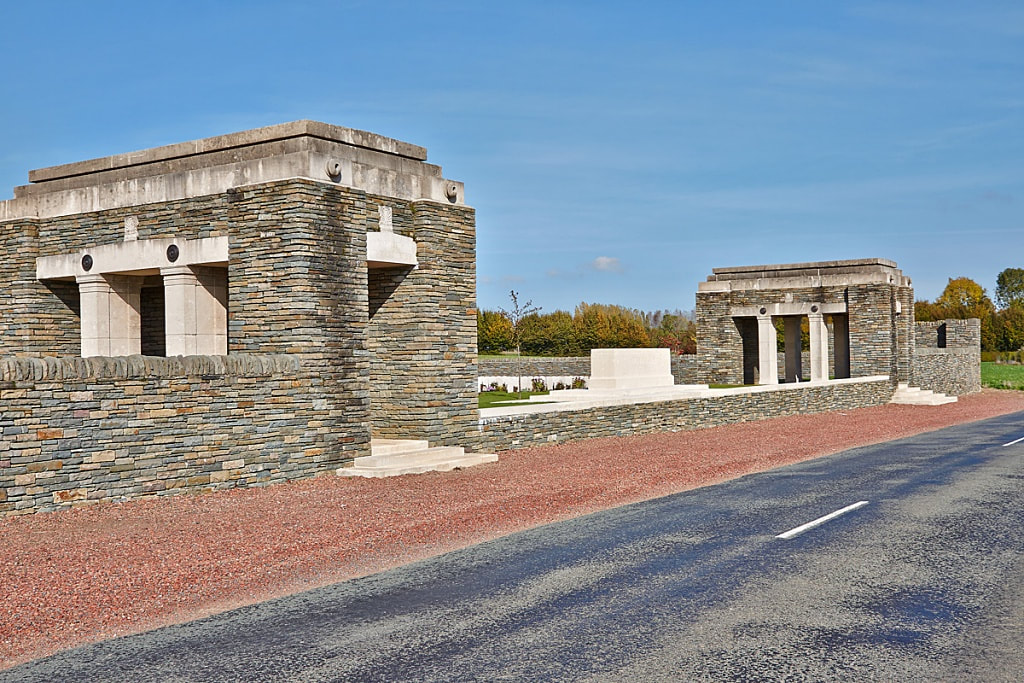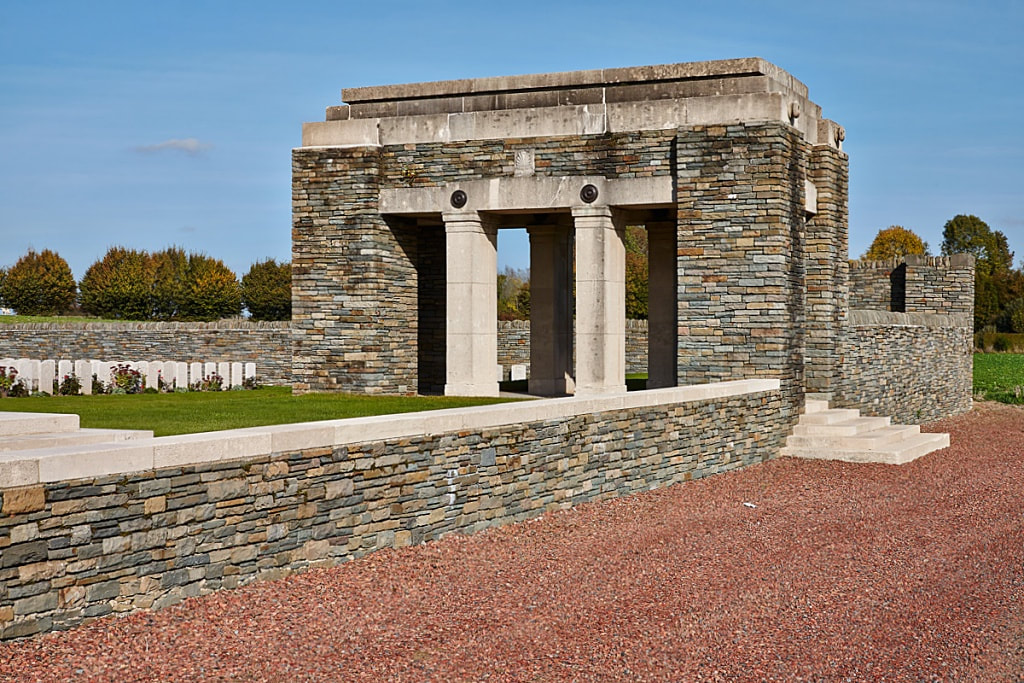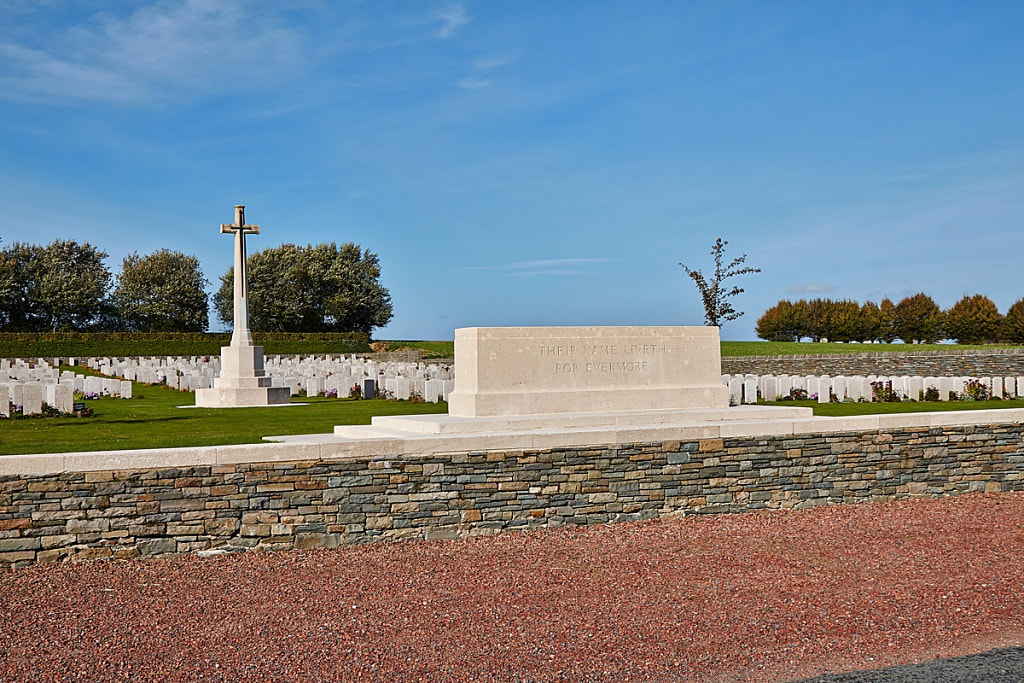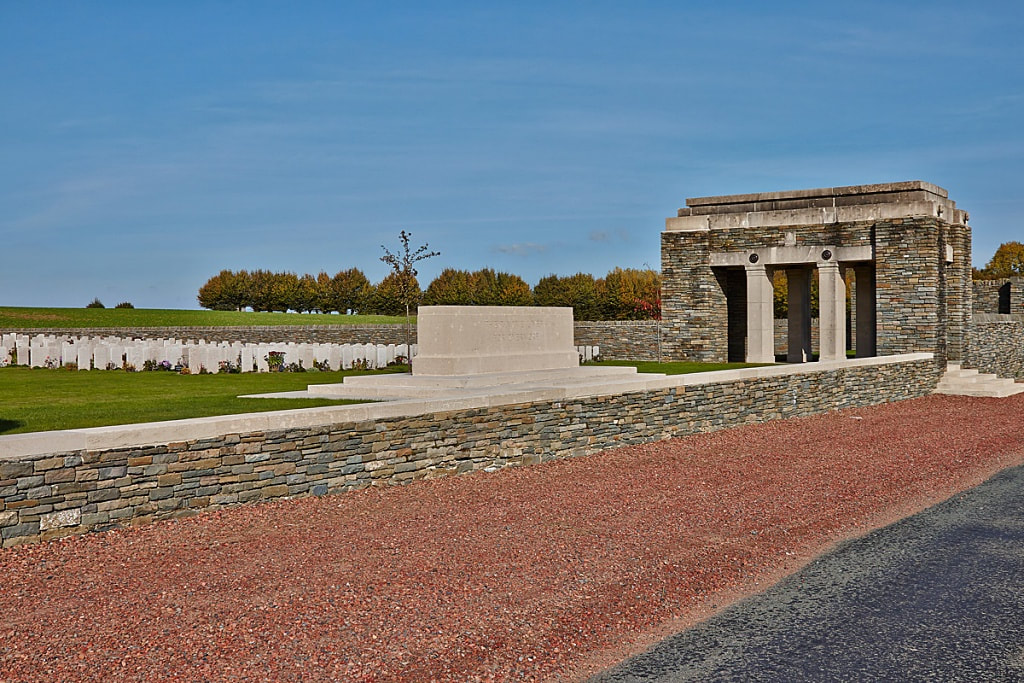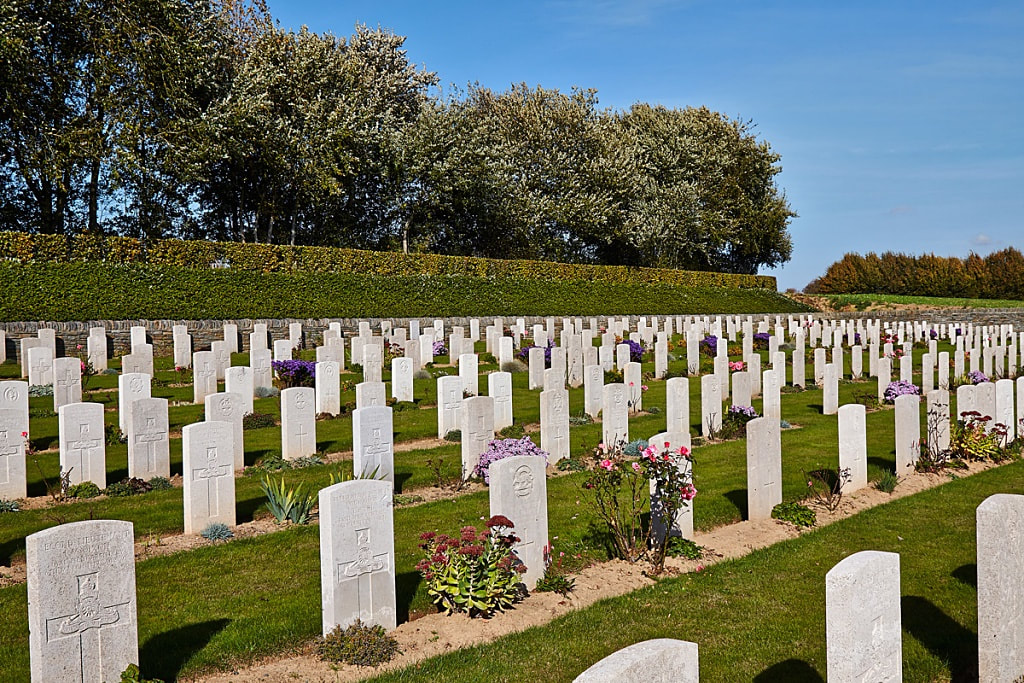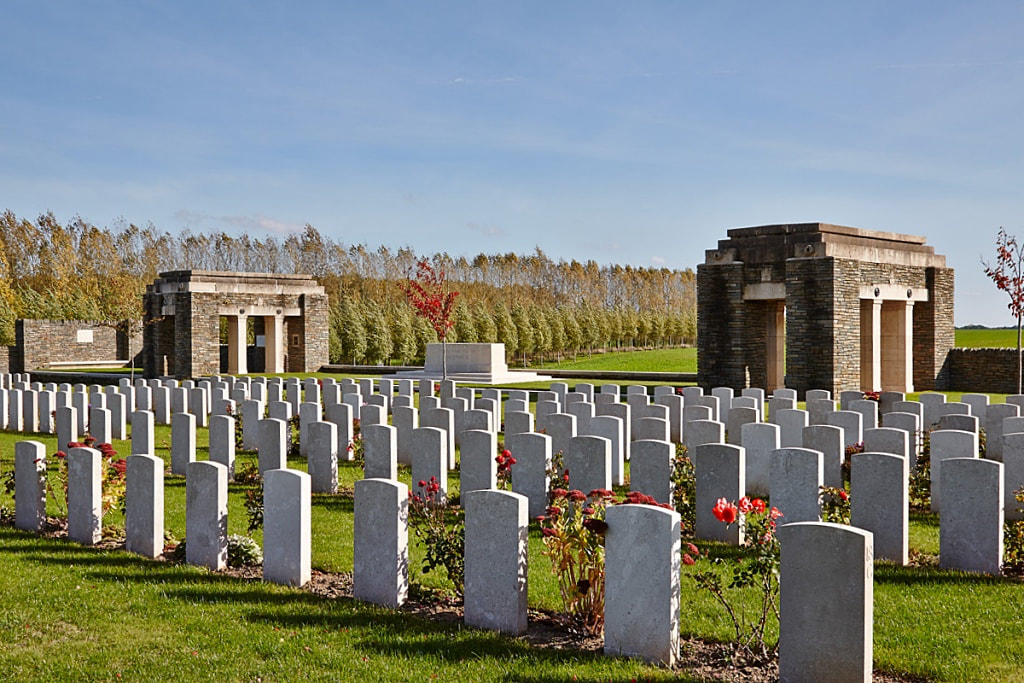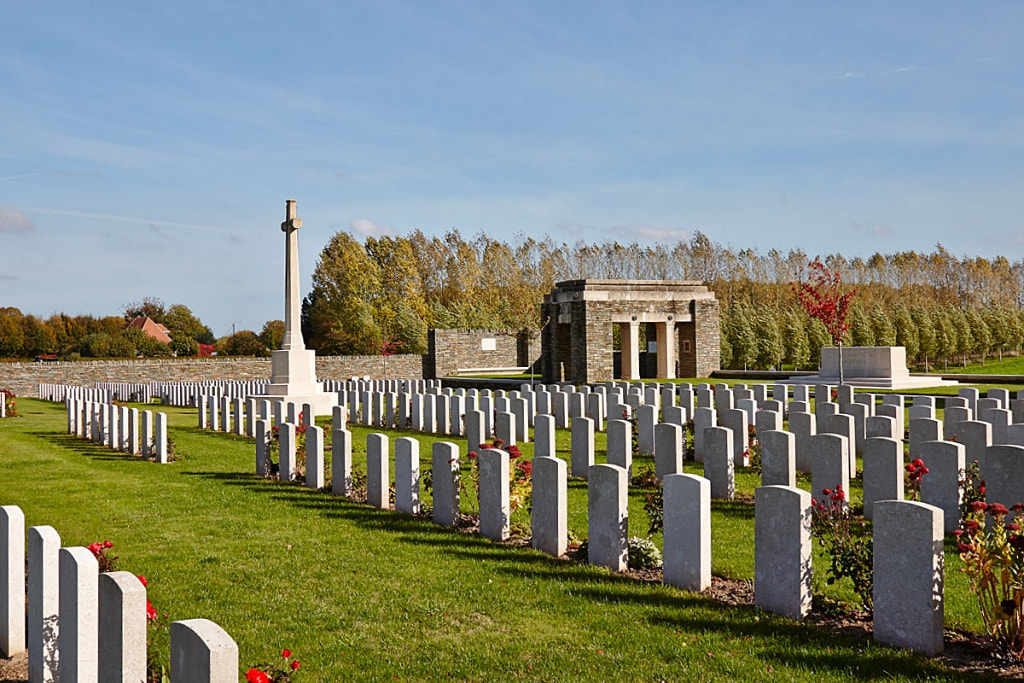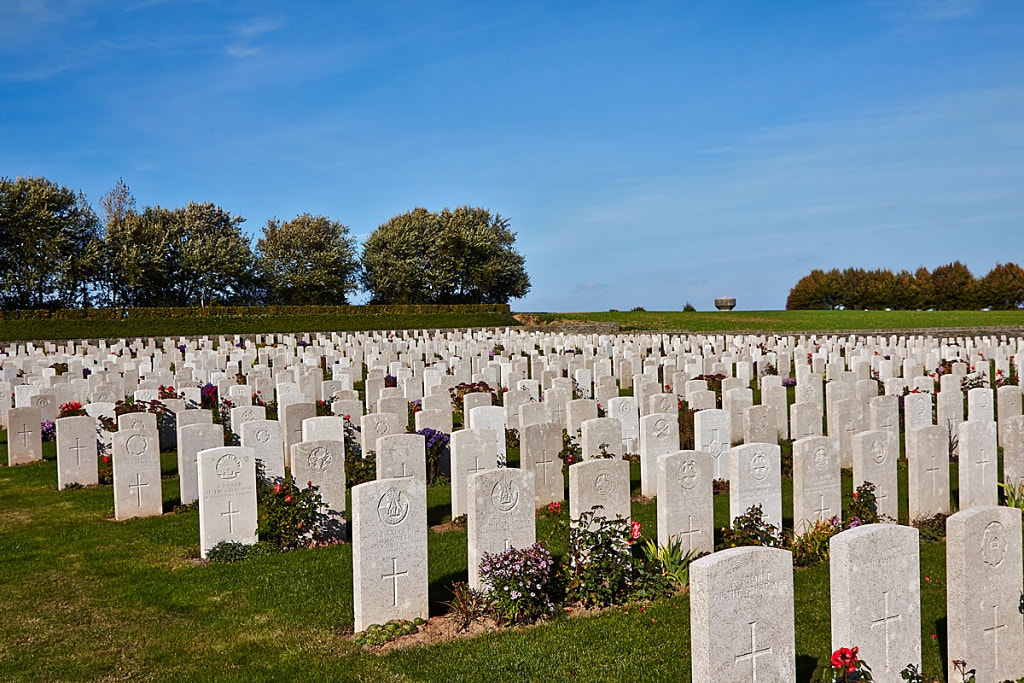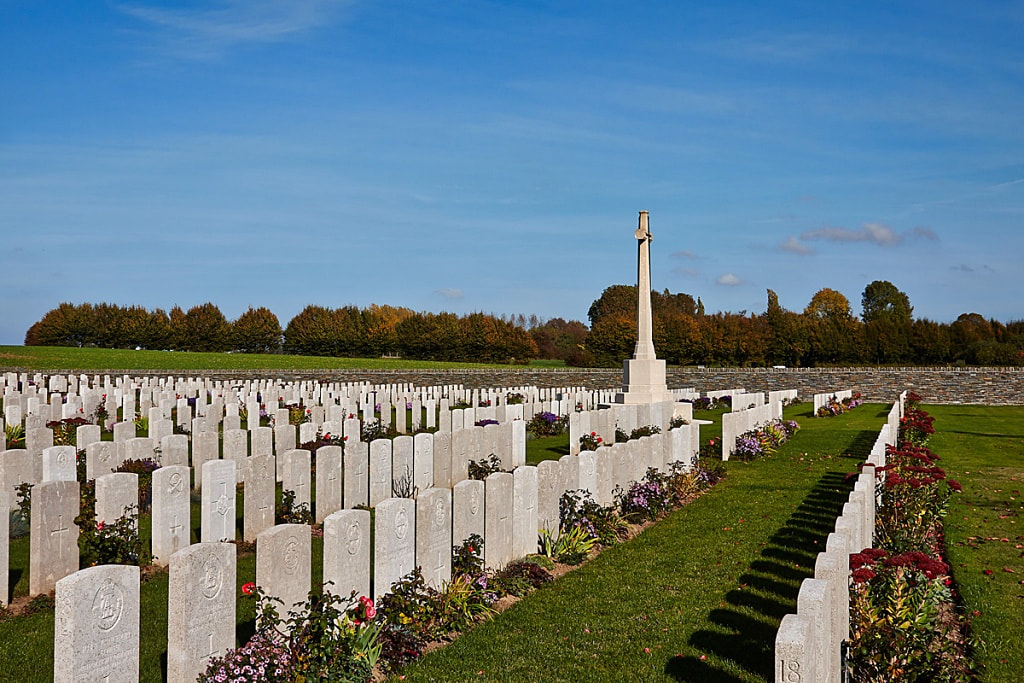BIENVILLERS MILITARY CEMETERY
Pas De Calais
France
GPS Coordinates: Latitude: 50.16936, Longitude: 2.60749
Location Information
Bienvillers is a large village in the department of the Pas de Calais 18 kilometres south-west of Arras. The Military Cemetery is just beyond the village on the south road leading to Souastre (D2). A CWGC signpost indicating directions to the site is situated on the village square.
Visiting Information
Wheelchair access to this cemetery with some difficulty.
Historical Information
Bienvillers Military Cemetery was begun in September 1915 by the 37th Division, carried on by other Divisions in the line until March 1917, reopened from March to September 1918, when the village was again near the front line, and completed in 1922-24 when a number of graves, mainly of 1916, were brought in from the battlefields of the Ancre. Its twenty-one plots show a remarkable alternation of original burials in regimental or divisional groups, and groups of concentrated graves.
The cemetery now contains 1,605 Commonwealth burials and commemorations of the First World War. 425 of the burials are unidentified but there are special memorials to two casualties known or believed to be buried among them.
The 16 Second World War burials all date from the early months of the war, before the German invasion in May 1940 forced the evacuation of the British Expeditionary Force from France.
Total Burials: 1,624.
World War One Identified Casualties: United Kingdom 1,165, New Zealand 9, Australia 5, Canada 1, Germany 1. Total 1,181.
World War One Unidentified Casualties: United Kingdom 402, Australia 20, Canada 2, South Africa 1. Total 425.
World War Two Identified Casualties: United Kingdom 16. Total 16.
The cemetery was designed by Charles Henry Holden & George Hartley Goldsmith
Lieutenant Colonel Walter Lorrain Brodie, V. C., M. C. Twice Mentioned in Despatches
2nd Bn. Highland Light Infantry
killed in action 23rd August 1918, aged 34.
Plot XVIII. F. 15.
Son of John Wilson Brodie, of 23, Belgrave Crescent, Edinburgh; husband of Grace Mary Brodie.
His headstone bears the inscription "In Proud And Loving Memory"
Citation:
An extract from the "London Gazette," No. 29005, dated 12th Dec., 1914, records the following:-"For conspicuous gallantry near Becelaere on the 11th November, in clearing the enemy out of a portion of our trenches which they had succeeded in occupying. Heading the charge, he bayoneted several of the enemy, and thereby relieved a dangerous situation. As a result of Lt. Brodie's promptitude, 80 of the enemy were killed and 51 taken prisoners."
Headstone
Images in this gallery © Johan Pauwels

306821 Private
John William Brown
2nd/7th Bn. Duke of Wellington's (West Riding Regiment)
27th March 1918, aged 42.
Plot XII. A. 11.
Son of Mr. and Mrs. Sam Brown, of Rastrick, Brighouse, Yorks.
John William Brown
2nd/7th Bn. Duke of Wellington's (West Riding Regiment)
27th March 1918, aged 42.
Plot XII. A. 11.
Son of Mr. and Mrs. Sam Brown, of Rastrick, Brighouse, Yorks.
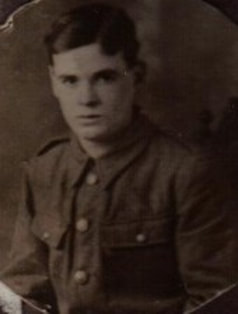
9543 Private
George W. Green
2nd Bn. South Staffordshire Regiment
13th July 1918.
Plot XVIII. C. 3.
Picture courtesy of William Carless
George W. Green
2nd Bn. South Staffordshire Regiment
13th July 1918.
Plot XVIII. C. 3.
Picture courtesy of William Carless

Lieutenant Colonel
Archibald Hugh James, D.S.O.
8th Bn. Northumberland Fusiliers, attd. 8th Bn. West Yorkshire Regiment (Prince of Wales's Own)
26th March 1918, aged 40.
Plot I. A. 24.
Son of William Edward Ashton James and A. Emily James, of Barrock Park, Cumberland.
Archibald Hugh James, D.S.O.
8th Bn. Northumberland Fusiliers, attd. 8th Bn. West Yorkshire Regiment (Prince of Wales's Own)
26th March 1918, aged 40.
Plot I. A. 24.
Son of William Edward Ashton James and A. Emily James, of Barrock Park, Cumberland.
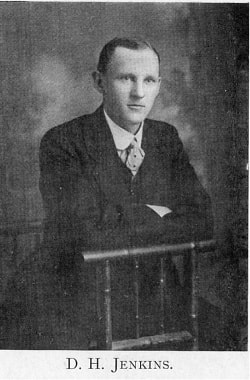
1427 Private
Daniel Harold Jenkins
1st Bn. Welsh Guards
27th May 1918, aged 30.
Plot XVIII. A. 7.
Son of David and Elizabeth Jenkins, of Llanon, Cardiganshire.
His headstone bears the inscription "Asleep in Jesus"
The information below supplied by 'The Ellesmerian Club', the alumni organisation for Ellesmere College where Daniel was a pupil.
Daniel Harold Jenkins
1st Bn. Welsh Guards
27th May 1918, aged 30.
Plot XVIII. A. 7.
Son of David and Elizabeth Jenkins, of Llanon, Cardiganshire.
His headstone bears the inscription "Asleep in Jesus"
The information below supplied by 'The Ellesmerian Club', the alumni organisation for Ellesmere College where Daniel was a pupil.
Daniel Harold Jenkins, born on 2nd November 1887 in Llansantffraid, Cardiganshire, was one of nine children of David and Elizabeth Jenkins of Millet Park, Llanon. On 1st April 1895 he started his primary education at Llanon National School.
In the summer of 1902, his father died and just three months later, in September, he was one of twenty new boys admitted to Ellesmere College in north Shropshire. There he was allocated to the ‘Arthur’ dormitory and Form Lower III under the guidance of Mr. Rees. There were just under two hundred boys on the nominal roll.
Daniel only stayed at the College for four terms and whilst records for the time are minimal it is known that he represented his dormitory on the cricket field in the summer of 1903 and moved up a year into Form IV.
After leaving Ellesmere in July 1903 he completed his secondary education at Aberaeron Secondary School, Llanon.
On 29th March 1913, he set sail for a new life across the Atlantic, departing Liverpool on the ss Franconia bound for New York. On the passenger manifest, he described himself as an engineer. How Daniel was employed whilst in the United States is not known but he obviously travelled widely around the continent as he returned to England on 17th May 1915 on the ss Reventazon (of the Fyffes Shipping Line) departing from Santa Marta, Columbia.
He had only been back in England for two days when he enlisted in Cardiff to become Private Jenkins, Service No.1427 in the 1st Battalion, the Welsh Guards. This regiment had been raised at White City by Royal Warrant on 26th February 1915 and had crossed to Le Havre on 18th August 1915 when it was attached to the 3rdGuards Brigade, the Guards Division. Daniel embarked for France on 16th September and would have been there for the Division’s first major action at the Battle of Loos on 25th September 1915.
The Division remained in the area during the following months where they also fought in the subsequent Action of Hohenzollern Redoubt. In July 1916, the Division moved to the Somme, where they fought at the Battle of Flers-Courcelette, and then at the Battle of Morval, capturing Lesboeufs Village. They remained here for the winter, and in March 1917 followed the German retreat to the Hindenburg Line.
Later that year they moved north to Ypres, where they fought at the Battle of Pilkem Ridge and then at the Battles of Menin Road, Poelcapelle and the First Battle of Passchendaele. November saw them move south again, where they took part in the Battle of Cambrai. They remained in the area over the final winter of the war and were stationed near Gouzeaucourt when the German spring offensive hit the area on 21st March 1918, at the Battle of St. Quentin.
Daniel was killed on the Somme on 27th May 1918, aged 30 years. He was buried at Bienvillers Military Cemetery, France.
His life is commemorated on War Memorials at Llansantffraid, Ellesmere College and Aberaeron School. He is remembered in various publications including the ‘List of Patriots who have joined and are serving in the British Army’ compiled by Llanon Mixed Boarding School and in Rolls of Honour held at Ellesmere College and at Aberaeron School.
He was awarded the Victory Medal, the British War Medal and the 1914-1915 Star.
In the summer of 1902, his father died and just three months later, in September, he was one of twenty new boys admitted to Ellesmere College in north Shropshire. There he was allocated to the ‘Arthur’ dormitory and Form Lower III under the guidance of Mr. Rees. There were just under two hundred boys on the nominal roll.
Daniel only stayed at the College for four terms and whilst records for the time are minimal it is known that he represented his dormitory on the cricket field in the summer of 1903 and moved up a year into Form IV.
After leaving Ellesmere in July 1903 he completed his secondary education at Aberaeron Secondary School, Llanon.
On 29th March 1913, he set sail for a new life across the Atlantic, departing Liverpool on the ss Franconia bound for New York. On the passenger manifest, he described himself as an engineer. How Daniel was employed whilst in the United States is not known but he obviously travelled widely around the continent as he returned to England on 17th May 1915 on the ss Reventazon (of the Fyffes Shipping Line) departing from Santa Marta, Columbia.
He had only been back in England for two days when he enlisted in Cardiff to become Private Jenkins, Service No.1427 in the 1st Battalion, the Welsh Guards. This regiment had been raised at White City by Royal Warrant on 26th February 1915 and had crossed to Le Havre on 18th August 1915 when it was attached to the 3rdGuards Brigade, the Guards Division. Daniel embarked for France on 16th September and would have been there for the Division’s first major action at the Battle of Loos on 25th September 1915.
The Division remained in the area during the following months where they also fought in the subsequent Action of Hohenzollern Redoubt. In July 1916, the Division moved to the Somme, where they fought at the Battle of Flers-Courcelette, and then at the Battle of Morval, capturing Lesboeufs Village. They remained here for the winter, and in March 1917 followed the German retreat to the Hindenburg Line.
Later that year they moved north to Ypres, where they fought at the Battle of Pilkem Ridge and then at the Battles of Menin Road, Poelcapelle and the First Battle of Passchendaele. November saw them move south again, where they took part in the Battle of Cambrai. They remained in the area over the final winter of the war and were stationed near Gouzeaucourt when the German spring offensive hit the area on 21st March 1918, at the Battle of St. Quentin.
Daniel was killed on the Somme on 27th May 1918, aged 30 years. He was buried at Bienvillers Military Cemetery, France.
His life is commemorated on War Memorials at Llansantffraid, Ellesmere College and Aberaeron School. He is remembered in various publications including the ‘List of Patriots who have joined and are serving in the British Army’ compiled by Llanon Mixed Boarding School and in Rolls of Honour held at Ellesmere College and at Aberaeron School.
He was awarded the Victory Medal, the British War Medal and the 1914-1915 Star.
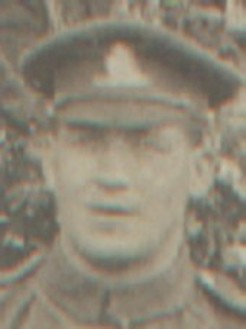
L/17147 Bombardier
John Linney
31st Div. Ammunition Column, Royal Field Artillery
31st May 1918, aged 30.
Plot XIX. C. 13.
Son of John and Mary Ann Linney, of 51, Bury St., Salford, Manchester.
Picture courtesy of Simon Lucas, Great nephew of this soldier
John Linney
31st Div. Ammunition Column, Royal Field Artillery
31st May 1918, aged 30.
Plot XIX. C. 13.
Son of John and Mary Ann Linney, of 51, Bury St., Salford, Manchester.
Picture courtesy of Simon Lucas, Great nephew of this soldier

Major
John Charles O'Callaghan, M. C. & Bar
"C" Battery, 190th Brigade, Royal Field Artillery
4th April 1918.
Plot XII. D. 7.
Son of Mr. C. O'Callaghan, of 156, High St., Lewisham, London.
John was born on 23rd September 1893, the son of Charles B B O’Callaghan (a
Bookseller) of 112 and later 156 High Street, Lewisham. On leaving Colfe’s he entered Christ’s Hospital School and in 1910 was working for the Lloyd’s Register of British and Foreign Shipping in Fenchurch Street. John joined up in October 1914 as a Private in the Honourable Artillery Company and became a Major with C Battery of the 190th Brigade of the Royal Field Artillery, serving in France and Italy. He was killed by a chance shell while on duty returning from an observation post in France on 4th April 1918 and is buried at Bienvillers Military Cemetery (XII.D.7).
M. C's
John was awarded the Military Cross ‘for conspicuous gallantry during operations near Contalmaison 9/10 July 1916, where the ammunition in a gun pit was ignited by a heavy enemy shell, and after a round had exploded, he
entered the pit with a driver and at great personal risk extinguished the fire and removed the ammunition’.
The Bar to his Military Cross was awarded ‘for conspicuous gallantry in action N. of Flers on 16.10.1916. He went out beyond the front line to observe for his battery while wire cutting, being exposed at the time to heavy fire. He has set a splendid example throughout the operations’.
Pictures and text courtesy of David Welch.
John Charles O'Callaghan, M. C. & Bar
"C" Battery, 190th Brigade, Royal Field Artillery
4th April 1918.
Plot XII. D. 7.
Son of Mr. C. O'Callaghan, of 156, High St., Lewisham, London.
John was born on 23rd September 1893, the son of Charles B B O’Callaghan (a
Bookseller) of 112 and later 156 High Street, Lewisham. On leaving Colfe’s he entered Christ’s Hospital School and in 1910 was working for the Lloyd’s Register of British and Foreign Shipping in Fenchurch Street. John joined up in October 1914 as a Private in the Honourable Artillery Company and became a Major with C Battery of the 190th Brigade of the Royal Field Artillery, serving in France and Italy. He was killed by a chance shell while on duty returning from an observation post in France on 4th April 1918 and is buried at Bienvillers Military Cemetery (XII.D.7).
M. C's
John was awarded the Military Cross ‘for conspicuous gallantry during operations near Contalmaison 9/10 July 1916, where the ammunition in a gun pit was ignited by a heavy enemy shell, and after a round had exploded, he
entered the pit with a driver and at great personal risk extinguished the fire and removed the ammunition’.
The Bar to his Military Cross was awarded ‘for conspicuous gallantry in action N. of Flers on 16.10.1916. He went out beyond the front line to observe for his battery while wire cutting, being exposed at the time to heavy fire. He has set a splendid example throughout the operations’.
Pictures and text courtesy of David Welch.

20202 Private
Ceasar Pickles
10th Bn. The Loyal North Lancashire Regiment
10th May 1916, aged 38.
Plot II. B. 4.
Husband of A. M. Pickles, of 32, Lime St., Colne, Lancs.
Ceasar Pickles
10th Bn. The Loyal North Lancashire Regiment
10th May 1916, aged 38.
Plot II. B. 4.
Husband of A. M. Pickles, of 32, Lime St., Colne, Lancs.

Lieutenant
Edgar Leslie Warman
No.1 Gun, Howitzer Bde. R.N. Div., Royal Marine Artillery
8th August 1918, aged 38.
Plot XX. E. 11.
Son of the late Mr. and Mrs. William Warman, of Stroud, Glos; husband of Glencora Isabel Warman, of 33, Junction Rd., Southsea, Portsmouth.
Edgar Leslie Warman
No.1 Gun, Howitzer Bde. R.N. Div., Royal Marine Artillery
8th August 1918, aged 38.
Plot XX. E. 11.
Son of the late Mr. and Mrs. William Warman, of Stroud, Glos; husband of Glencora Isabel Warman, of 33, Junction Rd., Southsea, Portsmouth.
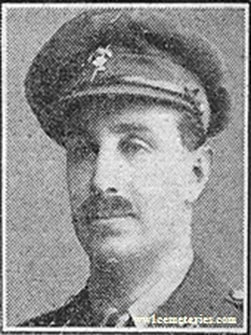
Lieutenant Colonel
Ronald Beaumont Wood, Mentioned in Despatches
12th (Prince of Wales's Royal) Lancers attd. 6th Bn. Tank Corps
21st August 1918, aged 36.
Plot XIX. E. 2.
Son of E. Herbert Wood and Evelyn A. Wood, of Isle of Raasay, Invernessshire and Newbold Revel, Rugby; husband of Inez Wood, of 71, Cadogan Place, London, S.W.I
Ronald Beaumont Wood, Mentioned in Despatches
12th (Prince of Wales's Royal) Lancers attd. 6th Bn. Tank Corps
21st August 1918, aged 36.
Plot XIX. E. 2.
Son of E. Herbert Wood and Evelyn A. Wood, of Isle of Raasay, Invernessshire and Newbold Revel, Rugby; husband of Inez Wood, of 71, Cadogan Place, London, S.W.I

R/4283 Rifleman
Cecil Henry Wooding
13th Bn. King's Royal Rifle Corps
2nd May 1916, aged 20.
Plot I. A. 94.
Son of Mr. and Mrs. William Wooding, of Castle Ashby, Northampton.
Cecil Henry Wooding
13th Bn. King's Royal Rifle Corps
2nd May 1916, aged 20.
Plot I. A. 94.
Son of Mr. and Mrs. William Wooding, of Castle Ashby, Northampton.
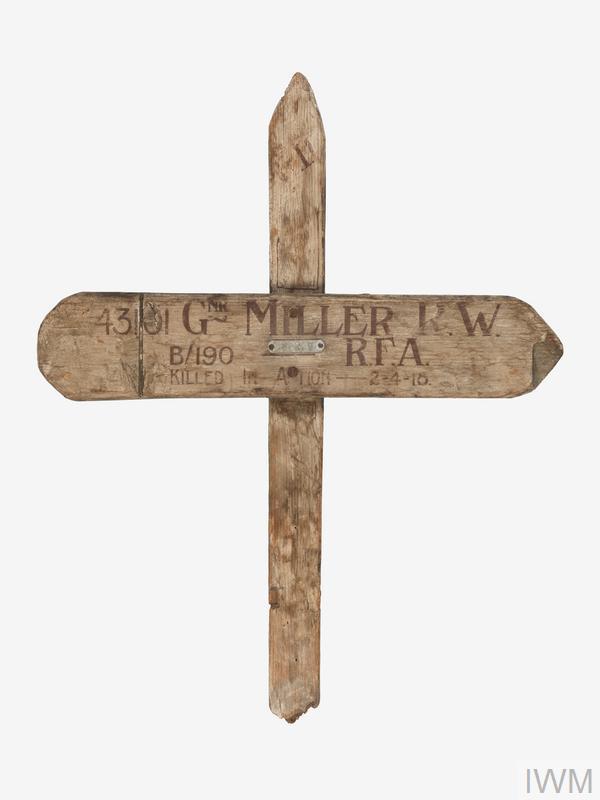
Original Graves Registration Unit (GRU) grave cross which marked the place of burial of (43101) Gunner Reginald William Miller (190th Brigade H.Q, Royal Field Artillery), who was killed in action on 2 April 1918. The cross which was improvised from fence wood is complete with the deceased's stencilled name and metal strip number tag. At the time of his death Gunner Miller was aged 19. His remains are now buried in Bienvillers Military Cemetery
© IWM (EPH 8612)



